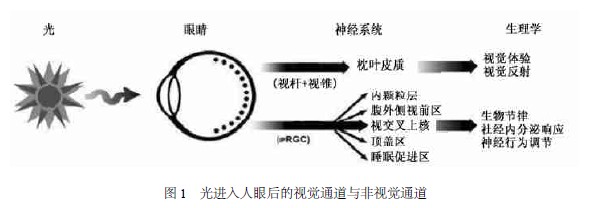Ju Jiaqi Chen Dahua Lin Yandan (Department of Light Source and Lighting Engineering, Fudan University, Shanghai 200433) Abstract: In 2002, the discovery of the third type of photoreceptor cells in the human eye, its influence on human circadian rhythms and biological effects, led people to re-examine and think about the definition of lighting quality. Starting from the introduction of the third type of photoreceptor cells, this paper defines the biological effect CPP value of illumination, calculates and compares the SPP value and CPP value of traditional light source and LED, and discusses the significance of non-visual biological effect of illumination on lighting quality assessment and LED practical application. Key words: non-visual biological effect; CPP value; lighting quality The Non2visual Biological Effect of Lighting and its Practical Meaning Abstract    The third photosensitive cells in the eyes were discovered in 2002. The influence on the circadian rhythm and other biological effects of our body will help to redefine the quality of lighting. The novel cells are introduced and the CPP value is defined. The SPP value and CPP value of fluorescent lamps and LED lamps are both calculated. The evaluation of lighting quality based on visual and non2visual effects and the application of LED are discussed in this article. Key words : non2visual biological effects ; CPP value ; quality of lighting 1. Non-visual biological effects of illumination In 2002, Berson, who Brown University found that a third type of photoreceptor cells in the mammalian retina, retina specialized light-sensitive ganglion cells (ipRGC), this type of photoreceptor cells in the body can be involved in the regulation of many non-visual biological effects, including the human body Changes in vital signs, hormone secretion and excitement. The discovery of light on the non-visual channel of the human body not only provides new research content for lighting science, but also puts forward new requirements for the research method of lighting science. The evaluation of the quality of the lighting is gradually over-evaluated by the single visual effect evaluation to the visual evaluation and the non-visual effect. The former focuses on visual functionality, while the latter is closely related to human health. The visual and non-visual channels of the human eye are shown in Figure 1. Studies have shown that the new photoreceptor cells not only participate in regulating the biological cycle rhythm of the human body, but also affect the secretion of melatonin. The melatonin level not only affects people's sleep quality, but also is related to inhibiting the growth of cancer cells. In today's vigorous promotion of people-oriented, healthy lighting, the non-visual biological effects of lighting have attracted widespread attention and research interest.
Ju Jiaqi Chen Dahua Lin Yandan
( Dept . Illuminating Eng. &Light Sources , Fudan University , Shanghai 200433)
For more than 150 years, scientists have always believed that rod cells and cone cells are the only photoreceptor cells in the human eye, explaining the human visual experience through the transmission of nerve signals between rods and cones and the visual cortex of the brain. Cone cells play a major role in the case of brightness levels greater than 3 cd/Pm2, thereby defining clear vision; while rod cells are primarily activated in the case of brightness levels less than 01001 cd/m2, thereby defining the brightness level Dark vision. Thus, the spectral sensitivity functions V (λ) and V' (λ) of the human eye in the bright visual state and the dark visual state are defined according to different brightness levels, and the response maximum values ​​correspond to 555 nm and 507 nm, respectively. 